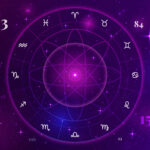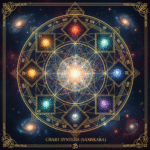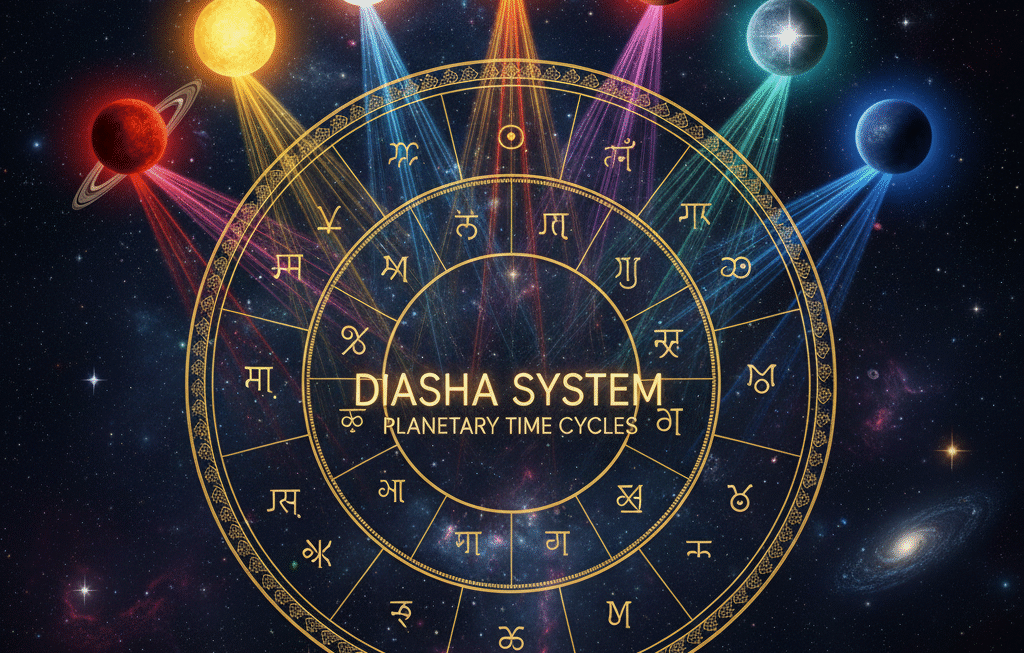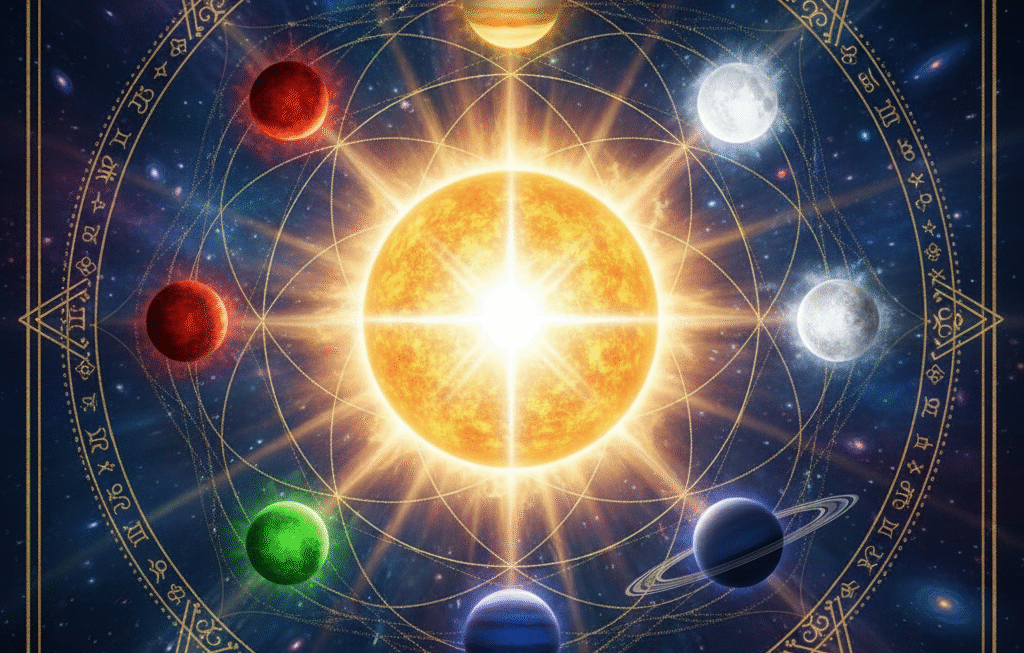You’ve learned the structure of the North Indian chart, where the houses are fixed. Now, prepare for a beautiful reversal. The South Indian birth chart, often called the square chart or Rasi chart, is fundamentally different in its visual geometry, yet the underlying principles of planets, signs, and houses remain the same.
The key to a successful South Indian kundli reading lies in mastering one core rule: The Zodiac Signs (Rashis) are fixed in their positions, and the Houses (Bhavas) move.1 This means the boxes themselves are permanently labeled with a sign, regardless of the person whose chart you are looking at.2
This guide will methodically walk you through the four key steps required to confidently read south indian chart and unlock its powerful insights.
1. The Fixed Framework: Memorizing the Square Chart Layout
The first step in any south indian kundli reading is to memorize the permanent layout of the 12 zodiac signs within the square chart. The signs never move from these boxes.3
- Opinion: This fixed-sign layout offers immediate clarity on which sign governs which area of the sky.
- Reason: Because the 12 boxes are permanently assigned to the 12 zodiac signs, the chart acts as a calendar, always beginning with Aries.4 You just need to learn the sequence, which moves strictly clockwise.
- Example:
- Aries (1) is always the second box from the top-left corner.5
- Taurus (2) is the box immediately to its right.
- Gemini (3) is the top-right corner box.6
- The signs continue clockwise around the perimeter of the chart, with Pisces (12) being the top-left corner box.7
- Opinion/Restatement: By internalizing this fixed-sign structure, you establish the permanent framework of the square chart.
| Sign (Rasi) | Number | Planet Lord | Fixed Box Location |
| Aries | 1 | Mars | Top Row, Second Box |
| Taurus | 2 | Venus | Top Row, Third Box |
| Gemini | 3 | Mercury | Top-Right Corner |
| Cancer | 4 | Moon | Right Side, Second Box |
| Leo | 5 | Sun | Right Side, Third Box |
| Virgo | 6 | Mercury | Bottom-Right Corner |
| Libra | 7 | Venus | Bottom Row, Third Box |
| Scorpio | 8 | Mars | Bottom Row, Second Box |
| Sagittarius | 9 | Jupiter | Bottom-Left Corner |
| Capricorn | 10 | Saturn | Left Side, Third Box |
| Aquarius | 11 | Saturn | Left Side, Second Box |
| Pisces | 12 | Jupiter | Top-Left Corner |
2. The Dynamic Point: Locating the Ascendant (Lagna)
Unlike the North Indian chart where the 1st House is fixed, in the South Indian chart, the houses rotate.8 The point of rotation is the Ascendant, or Lagna.9
OREO: Defining the Houses
- Opinion: Finding the Lagna is the only necessary step to determine all 12 houses in a South Indian chart.
- Reason: The Lagna represents the sign that was rising on the Eastern horizon at the moment of birth.10 That sign becomes the individual’s 1st House, orienting the entire map of their life.11
- Example:Now, look at your own chart. The Lagna is typically marked by an abbreviation like “As”, “Asc”, or “Lagna” placed within one of the fixed-sign boxes. Sometimes, it is simply indicated by a diagonal slash (/) across the box.
- If you find the ‘As’ marker in the box permanently assigned to Gemini (3), then the Gemini box becomes your 1st House.12
- If the ‘As’ marker is in the Scorpio (8) box, then the Scorpio box becomes your 1st House.13
- Opinion/Restatement: The sign where the Lagna is marked is your starting point—this is your 1st House, and the entire house system begins its clockwise count from here.14
3. The Flow of Life: Counting the Houses Clockwise
Once the Lagna (1st House) is identified, you must proceed clockwise to number the remaining houses sequentially.15
- Opinion: The clockwise counting direction is the core difference in chart reading methodology between the North and South Indian systems.16
- Reason: While the cosmic data is identical, the South Indian tradition uses a clockwise flow to map the 12 life areas (houses) across the fixed signs.17 This is a crucial step to avoid misinterpreting the chart.
- Example: Let’s say your Lagna is in Leo (5) (the box on the right side, third down).
- Leo (5) box = 1st House (Self/Personality)18
- Moving clockwise, the next box is Virgo (6) = 2nd House (Wealth/Family)19
- The next box is Libra (7) = 3rd House (Courage/Communication)20
- The count proceeds around the square until the 12th House, which is the sign immediately preceding the Lagna in the clockwise sequence. In this example, the Cancer (4) box becomes the 12th House (Loss/Detachment).21
- Opinion/Restatement: Correctly identifying the 1st House and counting clockwise to establish the rest of the houses is the key to mastering your south indian kundli.22
| House Number | Life Area (Bhava) | Determined By (in South Chart) |
| 1st | Self, Body, Life Path | Box with the ‘Lagna’ Mark |
| 4th | Mother, Home, Happiness | The box 4 steps clockwise from Lagna |
| 7th | Marriage, Partner, Business | The box 7 steps clockwise from Lagna |
| 10th | Career, Status, Reputation | The box 10 steps clockwise from Lagna |
4. Synthesis: Combining Planets, Signs, and Houses23
The final step is to combine the elements—Planets, their fixed Signs, and their calculated Houses—to perform a basic read south indian chart analysis.24
- Opinion: The power of the South Indian chart is how quickly you can identify the ruling planet of any house.
- Reason: Since the signs are fixed, you automatically know the ruling planet (Lord) of the 1st House, 2nd House, 3rd House, etc., the moment you find the Lagna. This instantly tells you which planet is responsible for which life area.
- Example: Assume your Lagna is in Aries (1) (1st House).25
- Aries (1) is ruled by Mars.26 Mars is your 1st House Lord (governs your identity).27
- The 7th House (Partnership) is found 7 steps clockwise, which is the Libra (7) box.28 Libra is ruled by Venus.29 Venus is your 7th House Lord (governs your spouse/partners).
- Now, look at the placements: If you see the symbol for Saturn (Sa) placed in the Aries (1) box (which is your 1st House).
- Planet: Saturn (delay, discipline, longevity).30
- Sign: Aries (fiery, independent, impulsive).
- House: 1st House (Self, body).31
- Interpretation: Your self (1st House) is colored by the disciplined nature of Saturn, but since Aries is a highly active sign, this may manifest as a person who takes life very seriously but channels their hard work into active, pioneering pursuits.
What do you see? Find your 10th House (Career) by counting 10 boxes clockwise from your Lagna. Which sign is in that box, and which planet is placed there? This tells you a powerful story about your professional destiny.
Conclusion: Your Journey into the Square Chart
You have now mastered the two major formats of the Vedic chart. Reading the South Indian kundli requires a slight mental shift—from fixed houses to fixed signs—but the elegance of its geometric layout quickly becomes intuitive.
You possess the foundational knowledge: the permanent cosmic setting of the signs, the dynamic placement of the houses beginning from the Lagna, and the clockwise flow of the life journey. Continue to practice combining these three factors (Planet + Sign + House), and the wisdom hidden in your square chart will steadily reveal itself.











